Chapter 6: production (methods of production)
1/98
There's no tags or description
Looks like no tags are added yet.
Name | Mastery | Learn | Test | Matching | Spaced |
|---|
No study sessions yet.
99 Terms
quantity food production involves control of
ingredients, production methods, quality of food, labor productivity, and energy consumption, all of which are critical to controlling cost
what is the highest cost item in a foodservice operation
production equipment
what are the 3 primary reasons for cooking food
Destruction of harmful microorganisms, thus making food safer for human consumption
Increased digestibility
Change and enhancement of flavor, form, color, texture, and aroma
quality of any cooked food depends on what 4 variables
Type and quality of raw ingredients
Recipe or formulation for the product
Expertise of production employees and techniques used in preparation
Method and duration of holding food items in all stages from procurement through service
METHODS OF PRODUCTION
what are the 4 ways heat is transferred
Conduction
Convection
Radiation
Induction
define conduction
Transfer of heat through direct contact from one object or substance to another.
In cooking by conduction, the heat is first transferred from a heat source, usually gas or electricity, through a cooking vessel to food.
Transfer can occur in any of the three states of matter: solid, liquid, or vapor.
define convection
Distribution of heat by the movement of liquid or vapor; may be either natural or forced.
natural occurs from density or temperature differences within a liquid or vapor
forced is caused by mechanical device
define radiation
Generation of heat energy by wave action within an object.
The waves do not possess energy but induce heat by molecular action upon entering food
what are the 2 types of radiation used in food production
infrared and microwave
define infrared waves
Type of radiation used in food production that has a longer wavelength than visible light.
Broiling is most familiar example of infrared cooking
define microwaves
Very short wavelengths that penetrate partway into food and agitate water molecules, causing friction to create heat.
The friction resulting from this agitation creates heat, which in turns cooks the product
define induction
Use of electrical magnetic fields to excite the molecules of metal cooking surfaces
The burner has no open flame and the burner surface does not get hot; rather, molecules in the pan are activated, which produce the heat to cook food.
cooking methods are classified as either what or what
moist heat or dry heat
what is meant by dry heat cooking
those in which the heat is conducted by dry air, hot metal, radiation, or a minimum amount of hot fat
what is meant by moist heat cooking methods
involve the use of water or steam for the cooking process.
combination cooking methods means what
apply both dry and moist heat to the menu item
equipment is identified as what 3 categories
moist heat
dry heat
multifunctional
define moist heat methods
Heat is conducted to the food product by water or steam
what are the moist heat cooking methods (7)
Boiling
Simmering
Stewing
Poaching
Blanching
Braising
Steaming
to boil simmer, stew, or poach means to cook food how
in water or seasoned liquid
what is boiling
to cook in a liquid that is boiling rapidly
what is simmering or stewing
cooking in a liquid that is boiling gently, with a temperature of 185°F to 205°F.
define steam-jacketed kettles
One kettle in a larger kettle with an open space, or jacket, between the two into which steam is introduced.
like a double boiler
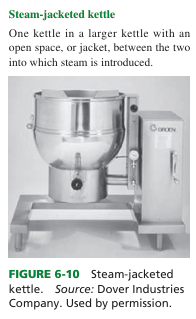
what is poaching
to cook in a small amount of liquid that is hot but not actually bubbling.
temperature range is about 160°F to 180°F
what is meant by blanching
defined as cooking an item partially and briefly, usually in water, although some foods, such as French fries, are blanched in hot fat
what is braising
involves cooking food in a small amount of liquid, usually after browning it.
aka pot roasting, swissing, and fricasseeing.
define steam
cook foods by exposing them directly to steam
define heat transfer rate
The amount of heat from one substance to another in a given amount of time in a given space measured in British thermal units (Btu)
define pressure steamer
Equipment that works by trapping and removing air from its cavity, causing steam pressure to build. Food is cooked by steam under pressure
2-5 psi low pressure or 15 psi high pressure
define Psi
Pounds per square inch, used to measure steam pressure
define pressureless convection steamer
Equipment in which heat is transferred from steam to food by forced convection caused by a fan inside that encircles the food.
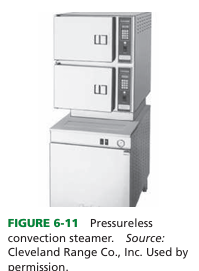
what are the dry heat cooking methods (10)
Roasting
Baking
Oven frying
Broiling
Grilling
Barbecuing
Rotisserie cooking
Sauteing
Pan frying
Deep fat frying
define broiler
Piece of equipment, gas or electric, that cooks food from a heat source above the food
food is placed 3 to 6 inches from the heat, depending on the type and intensity of the heat
define charbroiler
Either gas or electric equipment with a bed of ceramic briquettes above the heat source and below the grid.
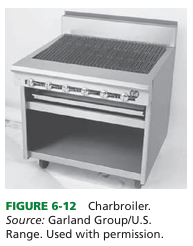
why is charbroiling a grilling method and not broiling method
Because the heat source is from below, it technically is a grilling and not a broiling method
define grilling
Cooking on an open grid over a heat source
define griddling
Cooking of food on a flat surface (griddle) that is heated from below by gas or electricity
define clamshell
Hinged or removable top with its own heat source that has been added to a gas or electric grill; permits cooking both sides of the food at one time.
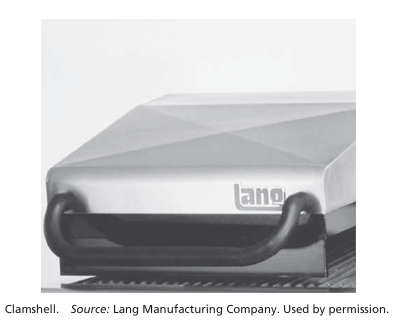
define deep fat fryer
Tank of oil or fat heated by gas or electricity into which foods are immersed; fryer has thermostatic control and fast recovery of fat temperature
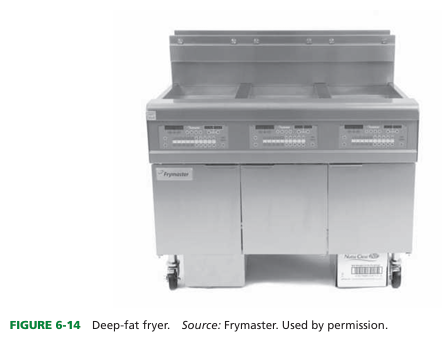
2 zones of frying kettle are
cooking zone and cold zonew
where is the cooking zone in frying kettle
above the heating elements
what is cold zone in frying kettle
which is the space below the cooking element where crumbs and debris fall
define heat recovery time
Amount of time for oil in fryer to return to optimum cooking temperature after food is added
Roasting or baking uses a combination of what heat transfer methods
conduction, convection, and radiation
define range oven
Part of a stove, generally called a range, located beneath the cooking surface
define deck oven
Oven that comes in basic sections, each with two shelves and its own source of heat, and that may be stacked on each other
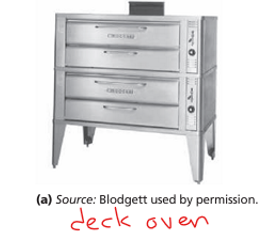
define convection oven
Oven with fan on the back wall that creates currents of hot air within the cooking chamber.
has more space and holds two to three times as much food, reduces cooking time by 30%, and cooks at 25 to 35°F lower temperatures, thus conserving energy
define conveyor oven
Oven, often called a pizza oven, with a belt running through a hot chamber on which products are baked.
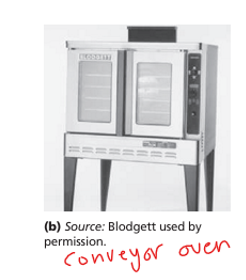
define impinger
Conveyorized gas-fired or electric oven that cooks products quickly at high temperatures from the top and bottom
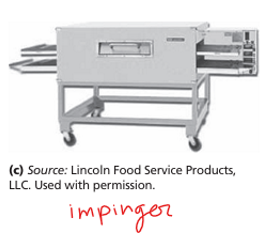
define microwave oven
an oven in which food is cooked by the absorption of microwave energy by water molecules in the food.
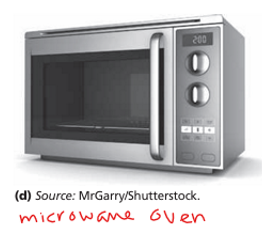
define smoker oven
Oven with racks to smoke meat
-uses wood chips to produce smoke, and the meat is rubbed with spices and barbecue sauce to give it a piquant flavor
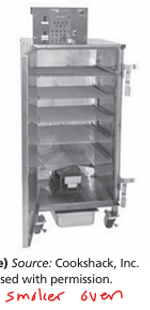
define smoker oven
define low temp cooking and holding oven
Ovens that cook at low temperatures and increase meat yield.
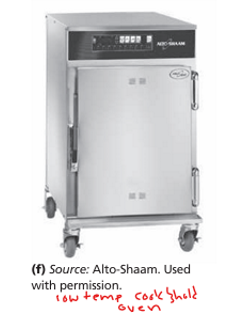
define rotisserie oven
Oven fitted with a spit or basket to al low food to be rotated over a source of heat.
define wood fire oven
Oven in which foods are cooked over burning wood.
define flash bake oven
Oven that uses a combination of intense light and infrared energy to quickly cook foods.
Products such as pizza, chicken breasts, and french fries can be cooked in much less time (2 minutes for a chicken breast, 1 minute for french fries)
Three pieces of cooking equipment are manufactured to alleviate many of the space and labor problems in a foodservice operation:
the combination convection oven/steamer or combi-oven
the tilting fry or braising pan
the convection/microwave oven.
define combi-oven
Oven that uses flow of both convected air and steam through oven cavity producing a super-heated, moist, internal atmosphere
Four cooking methods are combined in one unit: convection, steam, convection plus continuous steam, and convection plus cycled steam
define tilting skillet or tilting frying pan
Floor-mounted rectangular pan with a gas- or electric-heated flat bottom, pouring lip, and hinged cover
define convection/microwave oven
Multifunction equipment that can use convection air alone, microwave energy alone, or a combination of the two.
PRODUCTION CONTROL
control is what
the process of ensuring that plans have been followed
quality control means
assuring day-in, day-out consistency in each product offered for consumption
what is quantity control
means producing the exact amount needed—no more, no less
what relates directly to quality, quantity, and indirectly to control of cost
Time and temperature, product yield, portion control, and product evaluation
define time and temp control
Critical elements in quantity food pro duction that must be controlled to produce a high-quality product
Temperature is recognized as what related to cooking
the common denominator for producing the correct degree of doneness
define carry over cooking
The increase in internal meat temperature after removal from the heat source
define yield
Amount of product resulting at the end of the procurement/production process
define As purchases (AP)
Amount of food before processing
define Edible portion (EP)
- Amount of food available for eating after preparation and/or cooking
define Cooking losses-
Decrease in yield of many foods in pro duction primarily because of moisture loss.
define Handling losses
Decrease in the yield of a recipe because of preparation process
define portion control
Service of same size portion to each customer.
what may occur is portion sizes are not uniform (for customer)
Customers of any foodservice establishment are concerned about value received for price paid, and they may be dissatisfied if portions are not the same for everybody.
Achieving portion control results from what 3 important principles
Foods should be purchased according to detailed and accurate specifications to assure that the food purchased will yield the expected number of servings
Standardized recipes should be used.
Managers and employees should know the size and yield of all pans, dishes, and ladles.
define operation in the black
When revenue minus expenses is a positive value.
The key steps in ensuring portion control are (3)
purchasing by exact specifications
using standardized recipes
using proper tools and techniques during all aspects of production and service
define operation in the black
When revenue minus expenses is a positive value
EMERGENCY PREPAREDNESS
why is emergency preparedness important
A variety of events (weather, natural disasters, terrorist attacks, and pandemic illness) have prompted more detailed emergency preparedness planning by foodservice managers
what needs to be done to have emergency preparedness
determine the quantity of food, supplies, and water needed for an emergency situation, foodservice managers consider the numbers of people (patients, staff, students, public) expected to be served, how often meals will be served, what the basic components of each meal will be, and the ease in preparing the meals in situations of potential utility failure and staff shortages
what is a technique used to help train managers for emergency situation
table top drillde
define table top drill
Exercise that involves simulated emergency situations to test emergency plan
SUSTAINABLE PRODUCTION PRACTICES
sustainability wants today
Concern for the environment has prompted increased interest in sustainable practices in food production
what 6 factors are included in sustainable production practices
Sustainability
production control
Recycling
Food donation
Pulping
Composting
define composting
Decomposing organic material into soil-like material.
define anaerobic digestion
Use of microorganisms to break down organic matter and convert it to biogas
define direct energy
Energy expended within the foodservice operation to produce and serve meals
It is required for any storage, heating, cooling, packaging, reheating, distributing, or serving functions to be performed for any menu item prepared for service within a facility
three vital aspects of food quality that should be assured by the effective use of direct energy:
Sensory quality
Food safety
Nutrient retention
define indirect energy
Energy expended to facilitate functions that use direct energy.
supports the other necessary functions, like waste disposal, sanitation, and maintenance of the foodservice optimal work environment
for conserving energy, what program can orgs join and get certified for
ENERGY STAR® program
what is ENERGY STAR program
voluntary partnership among U.S. organizations, the U.S. Environmental Protection Agency (EPA), and the U.S. Department of Energy to promote energy efficiency in buildings and homes
tips to conserve energy
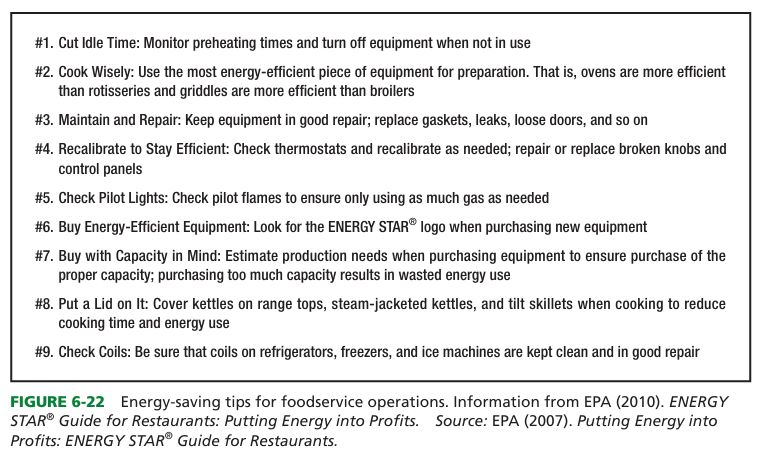
equipment that pass criteria for water conservation carry what logo
WaterSense® logo
energy management should be done how (like tracked)
Control of energy costs requires maintaining a record-keeping system for tracking utility costs and monitoring equipment use.
Energy use for lighting, heating, ventilating, and air-conditioning of the facilities must also be monitored and controlled.
what is one of the keys to a successful energy conservation program
employee training